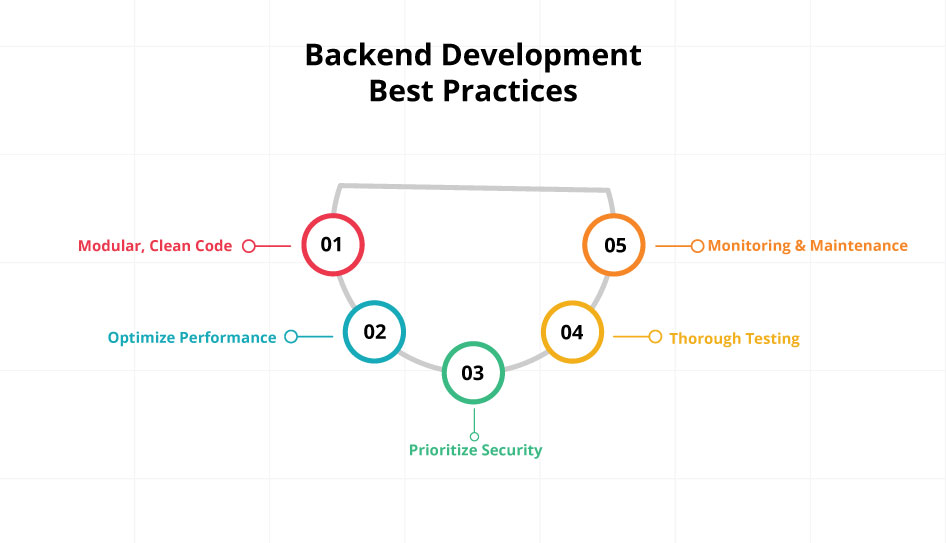How Backend Development Powers Your Product’s Core Functions

From seamless e-commerce transactions to real-time mobile app updates, the invisible engine making it all possible is often the backend. Backend development core functions operate behind the scenes to process requests, manage data, and ensure your product’s features work flawlessly for users. While users interact with the interface (front end), it’s the backend that does the heavy lifting – running business logic, querying databases, and maintaining the infrastructure that delivers a smooth user experience.
In this blog, we’ll explore the role of backend in product architecture, why the backend API and data layer are so important, how backend services power the frontend, tips on designing a backend for your product, and key backend development best practices.
Role of Backend in Product Architecture
In any software system, the backend is the foundation of the product’s architecture. Just as a building’s base supports everything above, the backend supports all user-facing features. It handles crucial tasks users don’t see – server-side computations, database operations, and integrations with other systems. These backend development core functions encompass implementing business logic, managing data, ensuring security, and maintaining the system’s architecture.
A well-architected backend means that as your product grows – more users, more data, more features – the system continues to perform reliably. The role of backend in product architecture is therefore pivotal. A weak backend can undermine even the best-designed front end, whereas a strong backend lays the groundwork for a responsive, scalable product.
Backend API and Data Layer Importance
An application’s backend typically provides an API and a data layer (database). The API is how the front end communicates with the server’s logic – every time a user logs in or requests data, it goes through an API endpoint to the backend. Designing clear API endpoints is crucial to exposing your backend development core functions in a controlled way. It ensures the front end can request the right operations and get proper responses (for example, receiving JSON data or confirmation messages).
The data layer is where the application’s information lives. This includes databases (and sometimes caches) that store everything from user accounts to transaction records. The backend API and data layer importance is evident: without a reliable data layer, your product couldn’t persist information, and without a well-built API, the front end couldn’t access that information. A robust backend will have efficient database design for fast queries, maintain data integrity and security, and scale to handle growth as your product’s data volume increases.
How Backend Services Power the Frontend
No matter how polished the interface is, it can only function as well as the backend behind it. Every button click or form submission on the front end triggers one of the backend development core functions on the server that does the heavy lifting. The backend service checks permissions, performs the required logic or database queries, and then sends back a result so the front end can update the UI. This dynamic of backend services powering frontend functionality means the front end is the “face,” while the backend is the “brain” of the operation. If the backend is slow or unresponsive, the user experience will suffer – even if the front end looks great.
Designing an Effective Backend for Your Product

Designing a backend for your product requires careful planning and the right choices up front. Key considerations include:
- Clarify Requirements & Architecture: Outline the core features and backend development core functions your backend must support. Choose an architecture that fits – a monolithic setup for simple apps or microservices for complex needs.
- Choose the Right Tech Stack: Select programming languages, frameworks, and databases that suit your project. For instance, enterprise projects may use custom Java development for high performance, while startups might choose Python or Node.js for faster iteration.
- Plan for Scalability & Security: Anticipate growth and protect data from day one. Use scalable infrastructure (cloud servers, load balancers, caching) and enforce security best practices (authentication, encryption, validation).
Every product is different, so tailor these principles to your context. For projects involving AI prototyping services or Robotics Development Services, ensure the backend can meet any extra data processing or device integration requirements involved.
Backend Development Best Practices

To keep your backend development core functions robust, here are some backend development best practices to follow:
- Modular, Clean Code: Organize code into logical components or services, making it easier to maintain and scale.
- Optimize Performance: Use efficient algorithms, optimize database queries (with indexing), and cache frequently used data to keep response times fast.
- Prioritize Security: Validate inputs, use proper authentication/authorization, encrypt sensitive data, and update dependencies to patch vulnerabilities.
- Thorough Testing: Write unit and integration tests, and use continuous integration to ensure changes don’t break existing functionality.
- Monitoring & Maintenance: Employ logging and monitoring tools to track performance and errors in production, and periodically refactor or update code to improve stability.
Conclusion
Backend development core functions are the backbone of every successful product. They ensure security, speed, and scalability while enabling seamless user experiences. A strong backend not only powers today’s needs but also prepares your product to adapt and grow with future demands.
At FX31 Labs, we design robust backends with expertise in custom Java development, AI prototyping services, and Robotics Development Services. Our solutions help enterprises build systems that scale reliably across industries like healthcare, finance, logistics, and gaming.
Looking to build a backend that’s secure, scalable, and future-ready?
Connect with FX31 Labs and let’s power your next big product.
FAQs
Q1. What is the role of the backend in product architecture?
A1. The backend is the foundation of a product’s architecture. It runs all the behind-the-scenes processes – from business logic execution to database management – that the front end relies on.
Q2. Why are the backend API and data layers important?
A2. The API is how the front end communicates with the backend’s functionality, and the data layer is where application data is stored. Without a good API, the front end can’t use backend features, and without a solid data layer, the application can’t reliably store or retrieve data.
Q3. How do backend services power the frontend experience?
A3. Backend services handle the work whenever the front end needs something. For example, if you click a button or request data, a backend function processes that action (e.g., fetching data from the database or performing a calculation) and sends the result back, allowing the front end to update what you see.
Q4. How to design backend for product?
A4. Start by defining the core features your backend must support. Then choose an architecture and tech stack suited to those needs. Design with scalability and security in mind from the beginning, and keep your code clean and well-tested so the backend remains reliable as you grow.
Q5. What are some backend development best practices?
A5. Key practices include writing modular, maintainable code, optimizing performance (using caching and efficient database queries), and implementing strong security measures (like input validation and encryption). It’s also best to test your code thoroughly and monitor your backend in production to catch and fix issues quickly.
